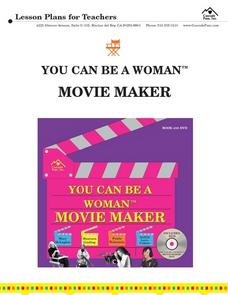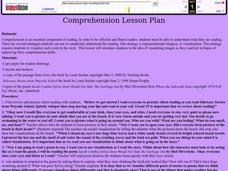Curated OER
YOU CAN BE A WOMAN MOVIE MAKER
High schoolers research and participate in activities to find out more information about women movie-makers.The use of reading a script and making storyboards are just a couple of examples.
Curated OER
Imagine This
Students practice visualizing as they read to aid comprehension. They then read a chapter in their history book and visualize what they read so that they can answer comprehension questions about the chapter.
Curated OER
Profiles of Maine Civil War Soliders
Eighth graders read letters of soldiers in the Civil War from the state of Maine. They create a soldier profile from the letters and draw what they believe the soldier looked like.
Curated OER
Summing It All Up
Students read articles and summarize the main points in this instructional activity. Students read a provided article from National Geographic Kids and create a web detailing the main points. They then use a six step process to write a...
Curated OER
Do You See What I See?
Learners participate in a reading skills lesson to improve reading comprehension. The skill of visualization is taught and practiced to help them better understand the plot of a story.
Curated OER
Comprehension
Students identify that comprehension is an essential component or reading and in order to be efficient and fluent readers. They interpret what they have read through various strategies. Finally, students use one of the strategies,...
Curated OER
Pope John Paul II's Complicated Legacy
Students closely examine the legacy of Pope John Paul II as well as that of other historical figures and draw conclusions about how prominent individuals are judged over time.
Curated OER
Japanese Objects as Cultural Artifacts: A Model Lesson Using Textiles
Middle schoolers complete a unit on the cultural significance of textiles in the Japanese culturre. They analyze cotton, line, silk, and wool fabrics, examine various fabric creation and decoration techniques, select an object and write...
Curated OER
African American Voices
Students investigate the many forms of Haitian art. They compare the art of some different cultures, religions, countries, and philosophies. Students also read the biography of an artist to build context for a particular piece of...
Curated OER
Picture It!
Pupils practice visualization by picturing themselves in their minds at the beach. They share their visualization describing what they see, feel, and what they are doing. They discuss the importance of visualization, to picture in their...
Curated OER
Around the World with Bud the Sub
First graders review the recently taught vowel /o/. They then form the sound for /u/ telling whether it is a closed or open vowel sound and repeat it several times together. They practice a /u/ tongue twister saying it together and...
Curated OER
All Ears
Students close their eyes and listen for one minute to whatever sounds occur. They write what they heard on slips of paper. They select some of these and write them down in a sequence that seems right to them.
Curated OER
Crawl Low Under Smoke
Students participate in a lesson that is about finding an escape route when faced with an emergency fire situation. They read about the hazards of fire and smoke inhalation. The concept of crawling low under smoke is emphasized and...
Curated OER
Plot Studies
Third graders are introduced to how to properly read a plot map. As a class, they take a field trip to an area surrounding the school and work together in groups to examine small sections of the different environments. To end the...
Curated OER
Tick-Tock Goes The Clock
Students examine the letter 't'. Through instruction and modeling they explore the sound the letter makes, how to make the sound with their mouths, how the letter is written, etc. They say tongue twisters with the /t/ sound in them. They...
Curated OER
Olly Olly Oxenfree
Students review short vowel sounds. They complete a variety of activities as they discover how to say the short /o/ sound, write the letter 'o', and pronounce words with the short /o/ sound. They read stories with short /o/ words in them.
Curated OER
What is an Expository
Students explore what qualities an expository has. They identify qualities of an expository in TEAMs after each book has been read. They explain the definition of an expository and why we write them.
Curated OER
Touchstones
Young scholars locate monuments in their neighborhoods and sketch them. They are shown slides of two modern monuments, the Vietnam Memorial and the Holocaust Monument in Edgewood Park. They read the article in National Geographic, Vol....
Curated OER
Medicine: Then and Now
Students read ancient Greek texts to explore ancient healing practices and compare them to those of modern times. They explain Greek healing practices for wounds.
Curated OER
The Name Game
Students identify acts of philanthropy in different works of literature. They idenify and illustrate examples in colonial America. They also read "Miss Rumphius" on how they can make the world a more beautiful place.
Curated OER
Heritage: Legends, Fairy Tales and the Native Americans
Fourth graders read a Native American legend local to the Utah region and compare it to a traditional European fairy tale. They use a Venn diagram as a graphic organizer for the comparison.
Curated OER
Date with Responsibility
Pupils discuss what it means to be responsible. As a class, they brainstorm a list of how they are responsible in their daily lives. In groups, they read the story of Liliuokalani and locate Hawai'i on a map. They discuss the...
Curated OER
Sand Island Story Mapping
After reading Under the Blood-Red Sun, by Graham Salisbury, young scholars use story mapping to create a visual representation of Hawaii. They include Pearl Harbor, Sand Island, and the Japanese relocation camp, where Tomikazu swims to...
Curated OER
Writing Letters
Third graders discover that second graders have written them letters and are anxious to receive letters back. They read the letters and review with the teacher the proper ways of writing letters and then write return letters using words...

























